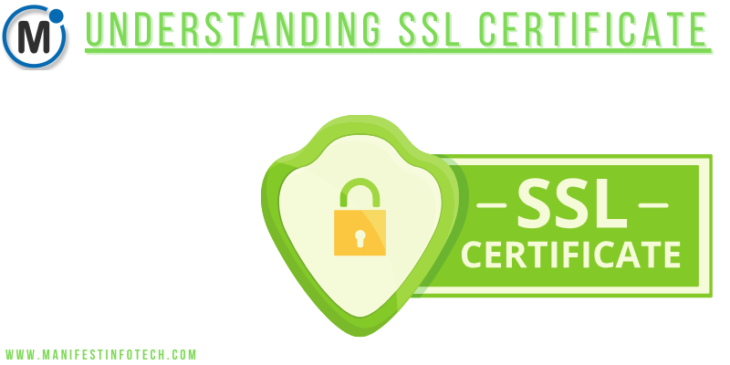
SSL (Secure Sockets Layer) certificates are a crucial component of internet security. They are used to establish secure and encrypted connections between a web browser and a web server. SSL certificates provide several key functions:
𝟏. 𝐀𝐮𝐭𝐡𝐞𝐧𝐭𝐢𝐜𝐚𝐭𝐢𝐨𝐧: SSL certificates verify the identity of a website. When a user visits a website with an SSL certificate, their browser checks the certificate to ensure that it was issued by a trusted Certificate Authority (CA). This helps users trust that they are connecting to the genuine website and not a malicious imposter.
𝟐. 𝐃𝐚𝐭𝐚 𝐄𝐧𝐜𝐫𝐲𝐩𝐭𝐢𝐨𝐧: SSL certificates encrypt the data transmitted between the user’s browser and the web server. This encryption makes it extremely difficult for third parties to intercept and decipher the data being exchanged. It ensures the privacy and integrity of data, such as login credentials, credit card information, and personal details.
𝟑. 𝐃𝐚𝐭𝐚 𝐈𝐧𝐭𝐞𝐠𝐫𝐢𝐭𝐲: SSL certificates also provide data integrity. They ensure that the data sent between the user and the server remains unchanged during transmission. If any tampering or alteration of the data occurs, the SSL connection is terminated.
𝟒. 𝐆𝐫𝐞𝐞𝐧 𝐏𝐚𝐝𝐥𝐨𝐜𝐤: When a website uses an SSL certificate, modern web browsers display a padlock icon in the address bar. This visual indicator informs users that the connection is secure. Additionally, the URL typically begins with “https://” instead of “http://,” where the “s” stands for “secure.”
𝟓. 𝐒𝐄𝐎 𝐁𝐞𝐧𝐞𝐟𝐢𝐭𝐬: Search engines like Google use SSL as a ranking factor. Websites with SSL certificates may receive a slight boost in search engine rankings compared to those without SSL, which can improve their visibility in search results.
𝗛𝗲𝗿𝗲’𝘀 𝗵𝗼𝘄 𝗦𝗦𝗟 𝗰𝗲𝗿𝘁𝗶𝗳𝗶𝗰𝗮𝘁𝗲𝘀 𝘄𝗼𝗿𝗸:
𝟭. 𝗖𝗲𝗿𝘁𝗶𝗳𝗶𝗰𝗮𝘁𝗲 𝗜𝘀𝘀𝘂𝗮𝗻𝗰𝗲: Website owners obtain SSL certificates from trusted Certificate Authorities (CAs). The CA verifies the website owner’s identity and domain ownership before issuing the certificate. Popular CAs include DigiCert, Comodo, and Let’s Encrypt.
𝟮. 𝗜𝗻𝘀𝘁𝗮𝗹𝗹𝗮𝘁𝗶𝗼𝗻: Once obtained, the SSL certificate is installed on the web server. This involves configuring the server software (e.g., Apache, Nginx) to use the certificate for secure connections.
𝟯. 𝗛𝗮𝗻𝗱𝘀𝗵𝗮𝗸𝗲: When a user’s browser requests a secure connection to the website, the server presents its SSL certificate. The browser then checks the certificate against a list of trusted CAs to ensure its authenticity.
𝟰. 𝗘𝗻𝗰𝗿𝘆𝗽𝘁𝗶𝗼𝗻: After the certificate is verified, the browser and server establish an encrypted connection using cryptographic algorithms. This encryption ensures that data transmitted between them cannot be easily intercepted or decrypted by unauthorized parties.
𝟱. 𝗦𝗲𝗰𝘂𝗿𝗲 𝗖𝗼𝗻𝗻𝗲𝗰𝘁𝗶𝗼𝗻: Once the SSL handshake is complete, the data exchanged between the user and the server is encrypted and secure. Any information, such as login credentials or payment details, is protected during transmission.
If you are looking for any services related to Website Development, App Development, Digital Marketing and SEO, just email us at nchouksey@manifestinfotech.com or Skype id: live:76bad32bff24d30d
𝐅𝐨𝐥𝐥𝐨𝐰 𝐔𝐬:
𝐋𝐢𝐧𝐤𝐞𝐝𝐢𝐧: linkedin.com/company/manifestinfotech
𝐅𝐚𝐜𝐞𝐛𝐨𝐨𝐤: facebook.com/manifestinfotech/
𝐈𝐧𝐬𝐭𝐚𝐠𝐫𝐚𝐦: instagram.com/manifestinfotech/
𝐓𝐰𝐢𝐭𝐭𝐞𝐫: twitter.com/Manifest_info
#SSL #Certificate #InternetSecurity #WebSecurity #DataEncryption #CyberSecurity #OnlinePrivacy #WebProtection #DigitalCertificates #HTTPS #SSLProtocol #DataSecurity #WebDevelopment #SSLAuthentication #SecureConnections #SSLBasics #WebsiteSecurity #SSLExplained #SSLTechnology #SSLBestPractices #SSLForBeginners #TLS (Transport Layer Security) #OnlineTrust #WebsiteEncryption #SSLBenefits #SecureBrowsing #DataIntegrity #OnlineSafety #DigitalSecurity #SSLTools